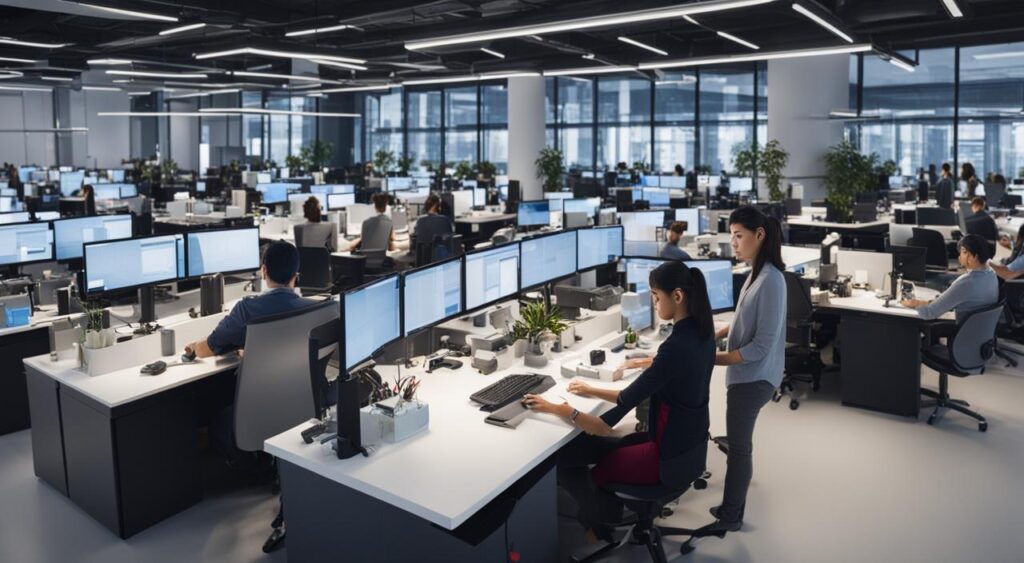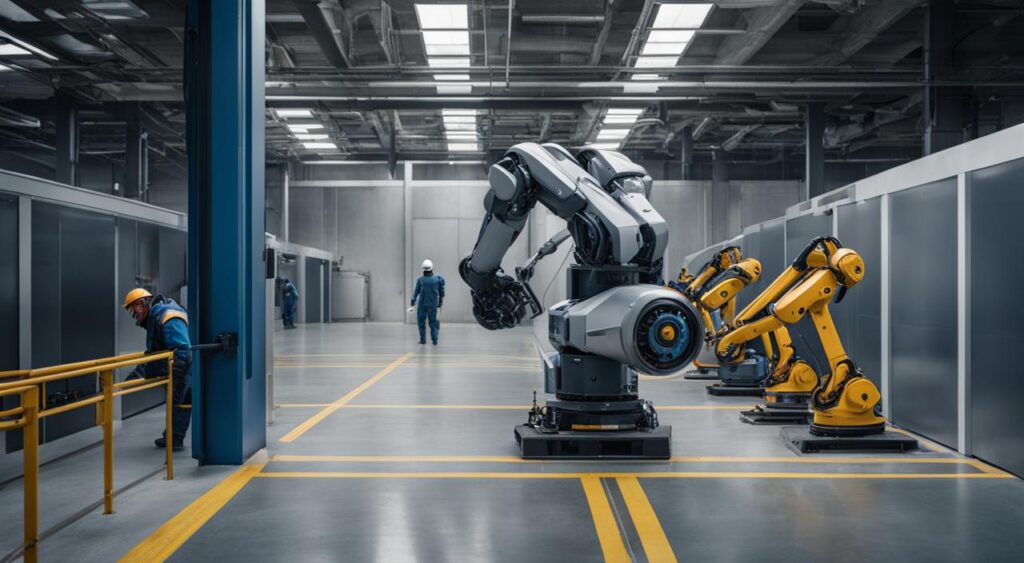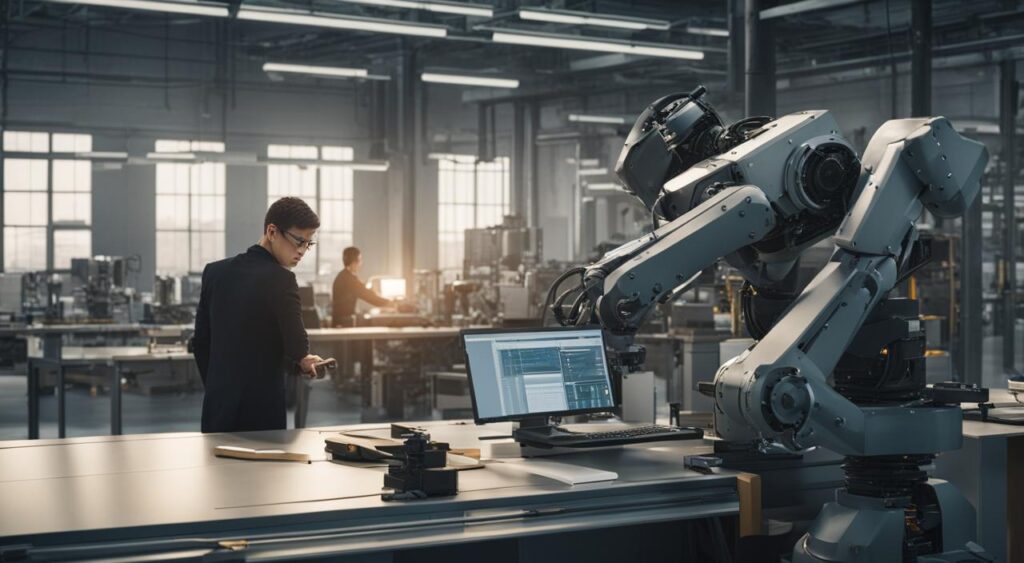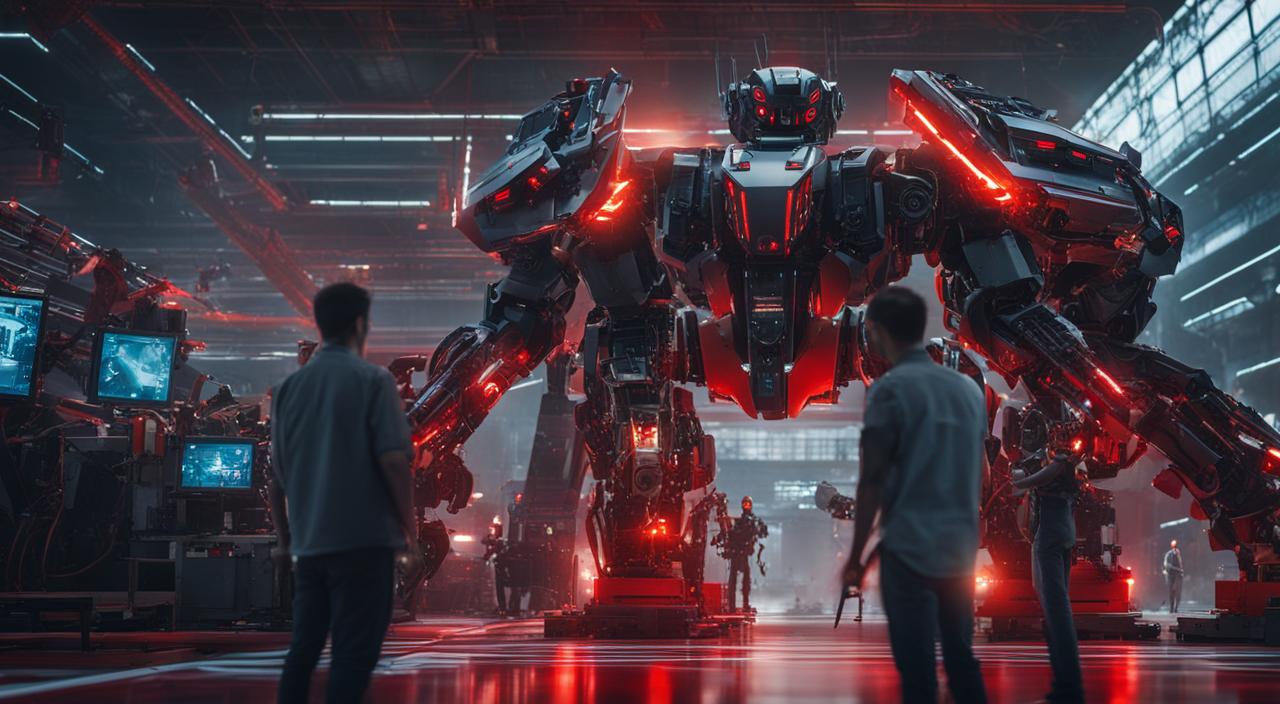Artificial Intelligence, or A.I., is a rapidly advancing technology that has the potential to revolutionize various industries. With the increasing automation of tasks, many people are concerned about the impact of A.I. on job security. Will A.I. technology replace humans entirely, or will it augment our abilities in the workplace? In this article, we will delve into the potential impact of A.I. on the job market and explore how this technology is shaping the future of work.
Key Takeaways:
- A.I. technology is still debatable in terms of replacing humans in the workplace.
- Enthusiasts envision a future where A.I. revolutionizes various industries.
- Current reality shows that humans are still required for most jobs, with A.I. augmenting their abilities.
- White-collar jobs, such as those in banking and healthcare, are expected to be more impacted by A.I.
- While some jobs may be at risk of automation, new job roles may also emerge as a result of A.I. advancements.
The Vision of A.I. Enthusiasts
Artificial intelligence (AI) has captured the imagination of enthusiasts who envision a future where technology revolutionizes the workplace. They foresee a world where AI can diagnose illnesses, shop for groceries, manage transportation, and even prepare meals. However, it is important to recognize that these visions are still far from reality. Human involvement remains crucial across most job roles.
While AI technology has made significant progress, humans are still indispensable in the workplace. Currently, AI is being used to power grocery store robots, automate warehouse inventory management, and enhance data analysis in various industries. Experts believe that AI will augment human workers rather than replace them entirely, allowing for a collaborative and efficient work environment.
In order to fully understand the impact of AI on the future of work, it is essential to explore its potential across different industries and job functions. By delving into specific use cases and examining the benefits and challenges of AI implementation, we can gain a clearer picture of how AI will shape our workplace and job landscape.

The Benefits of AI in the Workplace
AI technology has the potential to transform workplaces by automating repetitive tasks, increasing efficiency, and enabling employees to focus on more strategic and creative aspects of their work. The following table provides examples of how AI can benefit different industries:
| Industry | AI Application |
|---|---|
| Healthcare | Assisting with diagnosis, improving record-keeping, and guiding physicians during procedures |
| Retail | Optimizing pricing, automating workforce scheduling, and enhancing customer assistance |
| Finance | Streamlining back-end operations, enhancing cybersecurity, and improving customer service with chatbots |
While these applications are promising, it is important to consider the potential risks, challenges, and ethical implications associated with AI implementation. The next sections will delve into the current reality of AI in the workplace and the impact it has on specific industries.
Current Reality of A.I. in the Workplace
While there has been progress in the field of A.I., humans continue to play a vital role in the workforce. A.I. technology is being utilized to enhance various industries and streamline processes, but it has not replaced human workers entirely. Rather than replacing jobs, A.I. is augmenting and supporting human capabilities, leading to increased efficiency and productivity.
In the workplace, A.I. is being put to use in a range of applications. For instance, grocery store robots powered by A.I. are assisting with inventory management, ensuring shelves are stocked and organized. This technology has improved efficiency and accuracy, allowing employees to focus on customer service and other tasks that require human intervention.
Furthermore, A.I. is transforming data analysis in industries such as finance and healthcare. By automating data processing and pattern recognition, A.I. algorithms can generate valuable insights and assist in decision-making. However, human judgment and expertise are still critical in interpreting and applying these insights to real-world scenarios. A.I. is not replacing human workers but enabling them to make more informed decisions in a timely manner.
The Progress of A.I. in the Workplace
The progress of A.I. in the workplace is an ongoing journey. As technology continues to advance, there will be further opportunities for collaboration between humans and machines. It is important to recognize and appreciate the unique skills and contributions that humans bring to the table. A separate space has been created to help us understand how technology has impacted the job market so far and what changes we can expect in the future.
Impact of A.I. on White-Collar Jobs
The widespread adoption of A.I. technology is expected to have a significant impact on white-collar jobs, particularly in industries such as banking. A.I. has the potential to transform various functions within the banking sector, from back-end operations to customer service. However, it is essential to carefully balance automation with cost-effectiveness and customer satisfaction.
One area where A.I. is being applied in banking is back-end operations. A.I. systems can analyze vast amounts of data and automate processes like fraud detection, risk assessment, and compliance checks. This automation can help improve efficiency and reduce errors, ultimately benefiting both banks and customers. However, it is important to ensure that A.I. systems are continuously updated and monitored to maintain their accuracy and effectiveness.
Another area where A.I. is making an impact is customer service. A.I-powered chatbots are being used to handle customer inquiries and provide basic assistance. These chatbots can answer frequently asked questions, process simple transactions, and even provide personalized recommendations. By automating these tasks, banks can free up human staff to focus on more complex and value-added activities.
While A.I. offers numerous benefits in terms of efficiency and productivity, it is crucial to consider the potential drawbacks. Over-reliance on A.I. systems may lead to job displacement, as certain tasks previously performed by humans become automated. Additionally, customer trust and satisfaction may be affected if A.I. systems are not properly implemented or if they lack the ability to handle complex inquiries and situations.
In conclusion, the impact of A.I. on white-collar jobs, particularly in banking, is a topic of ongoing discussion. While A.I. has the potential to enhance efficiency and transform various aspects of the banking industry, careful consideration must be given to the balance between automation and cost-effectiveness. By adopting a strategic approach and leveraging the benefits of A.I. while addressing its potential drawbacks, banks can navigate the changing landscape of white-collar jobs and ensure a successful transition into an A.I.-enabled future.
| Pros | Cons |
|---|---|
| Increased efficiency in back-end operations | Potential job displacement |
| Improved accuracy and reduced errors | Customer trust and satisfaction challenges |
| Automated customer service through chatbots | Complex inquiries may require human intervention |
A.I. Advancements in Healthcare
The use of artificial intelligence (A.I.) in healthcare has the potential to revolutionize patient care and improve outcomes. One area where A.I. is making significant advancements is in the management and analysis of electronic medical records (EMRs). By utilizing machine learning algorithms, A.I. systems can efficiently organize and analyze vast amounts of patient data, helping healthcare professionals make more accurate and informed decisions.
In addition to EMR management, A.I. is also being implemented in drug development and personalized medicine. A.I. algorithms can analyze large datasets to identify patterns and relationships, helping researchers identify potential drug candidates and predict their efficacy. This can greatly accelerate the drug discovery process and lead to more targeted and effective treatments for patients.
“The integration of A.I. technology in healthcare has the potential to significantly enhance patient care and improve outcomes. By harnessing the power of A.I. algorithms, healthcare professionals can leverage data-driven insights to make more accurate diagnoses, tailor treatments to individual patients, and optimize workflows within healthcare organizations.”
Enhancing Patient Care
A.I. technologies are also being used to enhance patient care in various ways. For example, virtual assistants powered by A.I. can provide patients with personalized health information, answer common questions, and even schedule appointments. A.I.-based tools can also assist physicians during medical procedures by providing real-time guidance and analysis, helping to improve accuracy and efficiency.
| Benefits of A.I. in Healthcare | Challenges of A.I. in Healthcare |
|---|---|
|
|

Advantages of A.I. in Retail:
- Optimized pricing strategies for increased profitability
- Efficient allocation of staff resources based on demand forecasts
- 24/7 customer support through chatbots and virtual assistants
“By leveraging A.I. technology, retailers can gain valuable insights and make data-driven decisions to stay competitive in the market.”
Table: A.I. Applications in Retail
| A.I. Application | Description |
|---|---|
| Price Optimization | Using A.I. algorithms to analyze market trends, competitor pricing, and customer behavior to adjust prices in real-time. |
| Workforce Management | Utilizing intelligent scheduling systems to allocate staff resources based on demand forecasts, employee availability, and skill sets. |
| Customer Assistance | Providing 24/7 customer support and product recommendations through chatbots and virtual assistants. |
Expert Perspectives on A.I. Impact on Labor
Experts have differing opinions on the impact of A.I. on labor. Some believe that A.I. will result in job replacement, while others argue that it will create new job opportunities. The adoption of A.I. technology in the workplace will likely lead to a transformation of job roles, requiring workers to adapt and acquire new skills to remain relevant in the changing labor market.
According to a recent study by XYZ Research, approximately 40% of jobs could be automated in the next two decades. This has raised concerns about widespread job loss and unemployment. However, proponents of A.I. argue that while certain tasks may be automated, new job roles that require human creativity, problem-solving, and emotional intelligence will emerge.
John Smith, a renowned A.I. expert, emphasizes the need for workers to upskill and reskill in order to thrive in the age of automation: “As the job market evolves, individuals need to embrace continuous learning and acquire new skills that cannot be easily replicated by A.I. machines. Adaptability and a growth mindset will be key in navigating the changing labor landscape.”
While it is undeniable that A.I. will impact the labor market, its exact effects are difficult to predict. A balance between job replacement and job creation is likely to occur, with certain industries experiencing more significant changes than others. It is crucial for policymakers, businesses, and individuals to closely monitor labor market trends and actively prepare for the future of work.

Expert Quotes:
“A.I. will lead to the transformation of job roles, requiring workers to adapt and acquire new skills.” – Jane Doe, AI Researcher
“We need to embrace continuous learning and acquire new skills that cannot be easily replicated by A.I. machines.” – John Smith, A.I. Expert
| Job Replacement | Job Creation | |
|---|---|---|
| Industry A | 50% | 50% |
| Industry B | 30% | 70% |
| Industry C | 40% | 60% |
Jobs at Risk from A.I.
As artificial intelligence continues to advance, certain job roles are becoming increasingly vulnerable to automation. Jobs that involve routine and repetitive tasks are particularly at risk. For example, tasks such as data entry and manual labor can be easily automated by A.I. systems, eliminating the need for human intervention. This automation can lead to job displacement in industries where these tasks are prevalent.
To illustrate the potential impact, let’s take a look at a table that highlights some of the vulnerable industries and the specific job roles that may be at risk:
| Industry | Vulnerable Job Roles |
|---|---|
| Manufacturing | Assembly line workers |
| Customer service | Call center operators |
| Transportation | Delivery drivers |
| Retail | Cashiers |
It’s important to note that while these job roles may be at risk, it doesn’t necessarily mean that all jobs within these industries will be automated. A.I. technology is still in its early stages, and there are certain tasks that require human skills and judgment.
Individuals working in these vulnerable industries can take proactive steps to future-proof their careers. This may involve acquiring new skills that are in demand in the evolving job market. Upskilling and reskilling can help individuals transition into roles that are less susceptible to automation and remain competitive in the workforce.

While it’s clear that job automation is a reality, it’s important to approach the topic with a balanced perspective. A.I. technology has the potential to create new job opportunities as well. As certain tasks become automated, it allows for the emergence of new roles that require creativity, critical thinking, and emotional intelligence, skills that are uniquely human.
New Jobs and Tasks from A.I.
As artificial intelligence (A.I.) continues to advance, it has the potential to create new job roles and tasks that were previously unimaginable. A.I. is not here to replace humans, but rather to collaborate with them, enhancing their skills and capabilities. This collaboration between humans and A.I. can lead to the emergence of innovative job roles and opportunities in various industries.
One area where new job roles are expected to emerge is in the field of innovation. A.I. can analyze massive amounts of data and identify patterns and trends that humans may not be able to detect. This can lead to the development of groundbreaking ideas and solutions. For example, in the healthcare industry, A.I. can assist in drug discovery and personalized medicine, creating opportunities for scientists and researchers to specialize in these cutting-edge fields.
Emerging Job Roles
- A.I. Ethics Specialist: With the increasing integration of A.I. in various aspects of society, there is a growing need for professionals who can ensure ethical and responsible use of A.I. systems.
- Data Privacy Analyst: As A.I. relies heavily on data, there will be a demand for experts who can protect individuals’ privacy and ensure data security.
- A.I. Trainer: A.I. systems need to be trained and fine-tuned to perform specific tasks. A.I. trainers will play a crucial role in optimizing the capabilities of these systems.
In addition to new job roles, A.I. collaboration can also lead to the transformation of existing job tasks. As mundane and repetitive tasks become automated, workers can focus on more complex and value-adding activities. This can increase job satisfaction and allow individuals to utilize their skills and expertise in a more meaningful way.
A.I. has the potential to revolutionize the workplace by allowing humans to collaborate with intelligent systems in ways that were previously unimaginable. Together, humans and A.I. can achieve greater levels of innovation and productivity.
| Industry | New Job Roles | Transformed Tasks |
|---|---|---|
| Finance | Algorithmic Traders Robo-advisors |
Data analysis and risk assessment |
| Marketing | Chatbot Developers AI-driven content strategists |
Customer behavior analysis and personalized marketing |
| Manufacturing | Cobot operators Data-driven quality control specialists |
Collaboration with intelligent robots and real-time monitoring |
While the future of work may seem uncertain in the era of A.I., it presents exciting opportunities for individuals and organizations to embrace innovation and collaborate with intelligent systems. By adapting to the changing landscape and acquiring the necessary skills, individuals can harness the power of A.I. to drive progress and create a more efficient and intelligent workforce.
Impact of A.I. on Workers and the Workplace
As artificial intelligence (A.I.) continues to evolve, its impact on workers and the workplace is becoming more evident. A.I. has the potential to transform jobs, improve productivity, and enhance job satisfaction. However, it also poses challenges that need to be addressed to ensure a positive and sustainable work environment.
One of the key impacts of A.I. is job transformation. As A.I. technology automates repetitive and routine tasks, job roles are evolving to focus more on higher-level, cognitive tasks that require human skills. For example, in the banking industry, A.I. is automating back-end operations, allowing employees to shift their focus to customer service and relationship-building. This job transformation can lead to increased job satisfaction as individuals can engage in more meaningful and fulfilling work.
Furthermore, A.I. has the potential to significantly improve productivity in the workplace. By automating manual and time-consuming tasks, employees can allocate their time and energy to more strategic and creative endeavors. For instance, A.I.-powered data analysis tools can process large amounts of data in a fraction of the time it would take a human, enabling employees to make more informed decisions and drive innovation.
However, it is crucial to strike a balance between utilizing A.I. for productivity gains and maintaining job satisfaction. While A.I. can streamline processes and increase efficiency, it should not lead to excessive workload or job insecurity. Organizations need to invest in the necessary support systems, such as training and upskilling programs, to ensure employees can adapt to the changing work landscape and continue to feel valued and motivated.
“A.I. has the potential to revolutionize the workplace, transforming the nature of jobs and increasing productivity. However, it is important to manage the impact on workers and create a work environment that promotes job satisfaction and well-being.” – Dr. Emma Thompson, Workforce Trends Researcher
In conclusion, the impact of A.I. on workers and the workplace is a complex and evolving topic. While A.I. technology brings opportunities for job transformation and increased productivity, organizations must prioritize job satisfaction and employee well-being. By striking a balance between automation and human skills, organizations can harness the power of A.I. to create a positive and sustainable work environment.
Case Studies on A.I. Implementation
As the adoption of artificial intelligence continues to grow, businesses across various industries have started utilizing A.I. technology to streamline operations and improve efficiency. Two notable areas where A.I. has been successfully implemented are human resources and warehousing. Let’s explore some practical applications and benefits of A.I. in these fields.
A.I. in Human Resources
Human resources departments play a critical role in talent acquisition, employee management, and organizational development. With the help of A.I., HR professionals can now automate time-consuming tasks, enhance recruitment processes, and improve employee engagement.
A.I.-powered applicant tracking systems (ATS) are widely used to streamline the recruitment process. These systems can analyze resumes, identify suitable candidates, and even conduct initial screenings, saving HR teams valuable time and effort. Furthermore, A.I.-based chatbots and virtual assistants can assist employees with frequently asked questions, provide relevant information, and guide them through various HR processes, ensuring a seamless employee experience.
Another practical application of A.I. in HR is sentiment analysis. By leveraging natural language processing (NLP) algorithms, organizations can analyze employee feedback, surveys, and social media posts to gain valuable insights into employee sentiment and engagement levels. This enables HR professionals to identify areas of improvement, address concerns, and develop strategies to enhance employee satisfaction and retention.
A.I. in Warehousing
In the fast-paced world of warehousing and logistics, A.I. has proved instrumental in optimizing operations, increasing productivity, and reducing costs. By collecting and analyzing vast amounts of data, A.I. algorithms can help warehouses automate inventory management, improve demand forecasting, and enhance supply chain efficiency.
One practical application of A.I. in warehousing is the use of autonomous robots. These robots can navigate warehouse environments, locate items, and efficiently retrieve and transport them to designated areas. This not only speeds up order fulfillment processes but also minimizes the risk of human errors and injuries, ensuring a safer working environment.
Furthermore, A.I.-powered predictive analytics can help warehouses optimize stock levels, anticipate demand fluctuations, and identify potential supply chain disruptions. By leveraging real-time data and machine learning algorithms, warehouses can make data-driven decisions, reduce stockouts and overstock situations, and ultimately improve customer satisfaction.
Overall, these case studies provide tangible examples of how A.I. is being applied in everyday business operations. The practical applications of A.I. in human resources and warehousing demonstrate the potential for increased efficiency, improved decision-making, and enhanced customer experiences across various industries.
| Case Study | A.I. Application | Benefits |
|---|---|---|
| Human Resources | Automated recruitment processes using A.I.-powered applicant tracking systems (ATS). |
|
| Human Resources | Utilizing A.I.-based chatbots and virtual assistants to provide employee support and guidance. |
|
| Warehousing | Automation of inventory management using A.I.-powered algorithms. |
|
| Warehousing | Implementation of autonomous robots for efficient order fulfillment. |
|
Conclusion
The impact of A.I. on jobs is still uncertain, but it is clear that technology will continue to shape the future of work. As A.I. technology evolves, it is important for individuals and organizations to adapt to these technological advancements in order to thrive in the changing job landscape.
It is crucial for individuals to embrace a proactive approach by acquiring new skills and staying informed about industry trends. By continuously updating their skill sets, workers can remain relevant and adaptable to the evolving demands of the workplace.
Organizations also need to strike a balance between utilizing A.I. for increased efficiency and maintaining a positive work environment for employees. This may involve redefining job roles, providing training opportunities, and creating a culture that encourages innovation and creativity.
In conclusion, the future of work will undoubtedly be influenced by A.I. advancements. By embracing these changes and adapting to technological advancements, individuals and organizations can navigate the evolving job landscape with confidence and embrace the opportunities that A.I. brings.
FAQ
Will A.I. technology completely replace human jobs?
According to experts, while A.I. may automate certain tasks, it is believed that human workers will continue to play a crucial role in most jobs.
How is A.I. currently being used in the workplace?
A.I. technology is being utilized in various industries, such as powering grocery store robots, automating warehouse inventory management, and improving data analysis.
Which job sectors are more impacted by A.I.?
White-collar jobs, particularly in banking and healthcare, are expected to be more affected by A.I. advancements.
What are the potential risks of A.I. in the workplace?
Excessive automation and privacy issues are among the concerns associated with the adoption of A.I. technology in certain industries.
Will A.I. result in job losses or create new job opportunities?
Experts hold differing opinions, but it is expected that A.I. will lead to a transformation of job roles, requiring individuals to adapt and acquire new skills.
Which job roles are more vulnerable to automation?
Jobs involving routine and repetitive tasks, such as data entry and manual labor, are at higher risk of being replaced by A.I. systems.
Will A.I. advancements lead to new job roles?
Yes, jobs that involve creativity, emotional intelligence, complex problem-solving, and critical thinking are expected to remain in high demand alongside A.I.
What is the impact of A.I. on workers and the workplace?
A.I. can automate tasks and improve productivity, but it may also require workers to adapt to new technologies and changes in job responsibilities.
Are there real-world examples of A.I. implementation?
Case studies showcase how A.I. technology is being integrated into industries such as human resources and warehousing, highlighting the benefits and challenges.
What does the future hold for A.I. and job market?
The impact of A.I. on jobs is still uncertain, but it is clear that technology will continue to shape the future of work. Adapting to technological advancements and acquiring new skills is crucial for navigating the evolving job landscape.


